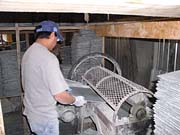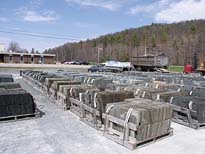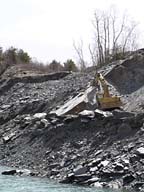

The company was founded in 1965 by David Camara, Sr., and he was eventually joined by his four sons -- Dave Jr., Mike, Shawn and Dan. The Camaras work in all aspects of the business, including sales, quarrying, fabricating and other operations
After initially operating as a buyer and seller of tile and flagstone, the company began buying salvaged roofing slate from structures around the Northeast during the early '80s. It sold the slate in markets that are heavy users of slate roofing, but are not producers - such as Louisiana and Texas.
In the mid-80s, the company began quarrying Unfading Green slate in Vermont, and it started fabricating its own floor tile, flagging and roofing slate products. Over the next few years, it opened several quarries in Vermont, including sites for Vermont Black, Semi-Weathering Gray and Sea Green slate. Today, the company owns 22 quarries for further expansion, and five are currently active. It produces every color of Vermont slate available. "Generally people think of slate as plain blue
or gray, without much color variation," said
Shawn Camara. "But the stone we've had the most success with is dark green. It has a lot of color variation in it."
Most of the company's production is roofing slate (70%), followed by floor tiles and flagstone. The company also sells slate countertops, and it supplies several wall cladding projects per year. Although countertop sales are a small component of the company's overall business breakdown, they are a growing sector. Camara estimates that the company sells two to three slate countertops per week during the winter months and five to seven countertops a week during the summer.
Camara pointed out that the technical qualities of Vermont slate make it an ideal material for kitchen countertops. He cited a low water absorption rate of 0.13 to 0.20% and a modulus of rupture at 10,000 to 13,000 psi, which he said compares favorably to some inferior slate varieties. All countertops from the company are given a warranty of 30 years against delaminating and powdering.
In order to sell the concept of slate countertops to homeowners, the company had to correct some misconceptions in the marketplace. "Many homeowners were afraid that slate would stain, so we let people test them," Camara said. "They've tried different solutions on the stone, and it couldn't be stained. We once did a job with a geologist, and she did a lot of testing on her own and couldn't stain it. Some people take a tremendous amount of time to learn the product, which is exactly what we want."

Slate production
The production totals at Camara Slate Products are 30,000 square feet of roofing slate per week and 25,000 square feet of floor tiles and flagging. "What distinguishes our company from others is the quality," said Camara. "We haven't marketed our products heavily. It's basically been word of mouth."The company also buys and sells roofing slate from smaller quarries, and it is actively involved in the salvaged stone market. It has two crews for recovering slate roofing from buildings, and during the summer months, they retrieve 80 to 120 squares of roofing slate per week.
Camara Slate Products has a staff of 45 people, including eight quarry workers and 34 employees in the mills. The company has a total of three mills for processing quarried slate. Two of the facilities are concentrated on roofing slate, while a third processes tiles, flagging and architectural pieces.
In quarrying the slate, the material is drilled perpendicular to the natural cleave of the stone. And since this cleave can pitch as much as 60 degrees, the process for drilling the stone has historically been very labor-intensive. Workers equipped with hand drills were attached to the face of the stone with ropes and harnesses so they could make the holes. This process received a dramatic upgrade recently with the addition of a John Henry Rock Drill -- essentially a large-scale jackhammer attached to a backhoe. "Now, we can do in two hours what used to be done in four days," Camara said. The jackhammers drill 12 feet deep in increments of 2 feet each, and black powder blasting is then used to free the stone from the quarry face.
The mill that produces slate tiles and flagging is located adjacent to the quarry sites for green and purple slate. Blocks are brought to the mill, cut with a series of saws to the needed dimensions and then cleaved by hand. According to Camara, a good-sized block of slate is 8 or 9 feet long x 5 to 6 feet wide in size.
In the mills for producing roofing slate, much of the machinery in operation is the same that could be found decades ago. Workers operate traditional equipment for trimming, although the company has also added some automated machinery for edging and hole punching. Still, the craftsmanship for slate production is always in demand, as many of the final products require the hand splitting of the slate at some point in the process. Fortunately for Camara Slate Products, they have been able to retain many of their employees over the long term. "We make sure they have decent pay and insurance, and we treat them like we would want to be treated," Camara said.
Camara Slate Products' business is spread around the country, including clients in Texas, Louisiana, Oklahoma, Colorado as well as Northeastern markets such as Boston, New York, New Jersey, Philadelphia and Washington, DC. The company sells to smaller distributors, and it also sells to roofers, but they do not represent a prime market for the company. With the increased popularity of large-format slate products, Camara is looking to align itself with a company to sell slabs for cladding or countertop applications across the U.S.
From 1990 to 2000, the company enjoyed growth of 30% per year, and last year, growth continued at a rate of 11%. But even with this growth, the close-knit Camara family has remained true to its roots. "We're a small family business that's grown up," said Camara.
